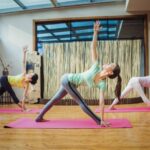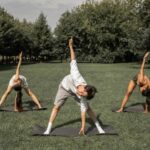Flexibility is an essential component of overall health, often overshadowed by the emphasis on strength and cardiovascular fitness. Yet, the capacity to move joints through their full range of motion not only enhances athletic performance and the execution of daily activities but also contributes to a balanced musculoskeletal health. Regular stretching routines can lead to improved posture, reduced risk of injury, and lessened muscle tension, which collectively foster a better functioning body.
In the realm of mental well-being, the benefits of flexibility are equally noteworthy. As individuals participate in consistent stretching activities, they often experience a reduction in stress and an augmented sense of physical relaxation, which can translate to a more peaceful state of mind. This holistic approach reinforces the interconnectivity between physical flexibility and mental clarity.
Furthermore, flexibility training is vital in maintaining the lubrication and nourishment of joints. Through the increased circulation of synovial fluid, which arises from flexibility exercises, joints are afforded greater movement and less discomfort, thereby mitigating the risks that accompany a sedentary lifestyle or aging, such as falls and balance issues. With these considerations in mind, incorporating flexibility training into one’s routine is not simply about achieving greater physical pliability, but about nurturing a resilient and healthy body.
Understanding Flexibility and Its Importance
Flexibility, a critical component of physical fitness, involves the ability of muscles and joints to move through their full range of motion without discomfort.
Defining Flexibility and Its Role in Health
Flexibility is the measure of the ability of muscles and joints to stretch and move freely. This physical attribute is essential for performing everyday activities and exercises safely and effectively. It contributes to easing movement and reducing the risk of injury, especially during physical activities.
The Impact of Age on Flexibility
As individuals age, they often experience a natural decrease in flexibility. This can be attributed to changes in the muscles and joints, including a reduction in elasticity. It’s important for one to maintain an active lifestyle that incorporates flexibility exercises to combat the effects of aging and maintain range of motion.
Genetics and Flexibility: What You Can’t Control
Genetics play a significant role in determining one’s baseline flexibility level. While everyone can work to improve their flexibility, genetic factors can set a natural limit on the extent of one’s range of motion. Understanding this can help set realistic expectations and goals for flexibility training.
The Science of Stretching
In the realm of physical fitness, the act of stretching is central to enhancing flexibility and maintaining muscle health. This section will explore the different types of stretches, the physiological mechanisms of stretching, and the impact on muscle and joint function.
Types of Stretching: Static vs. Dynamic
Static stretching involves holding a stretch in a challenging but comfortable position for a period of time, usually between 30 to 60 seconds. This type of stretching is beneficial for improving flexibility and is typically performed at the end of a workout session. In contrast, dynamic stretching consists of controlled movements that prepare muscles and joints for a range of activities, often used as part of a warm-up routine.
- Static stretches might include a hamstring stretch or a tricep stretch held for a duration.
- Dynamic stretches could encompass leg swings or arm circles that move the limbs through their full range of motion.
The Physiology Behind Stretching and Increased Range of Motion
Stretching systematically works by elongating muscle fibers to increase the range of motion in the joints. When a muscle undergoes a static stretch, it should be done gently and without bouncing to prevent injuries and to promote muscle lengthening. Over time, regular stretching can adjust the length-tension relationship within the muscle, allowing for a greater range of motion and reducing the risk of strains or damage during physical activity.
- Muscle groups benefit from regular stretching, as it helps prevent the shortening and tightening that can occur from disuse or repetitive use.
- An increased range of motion aids in the performance of daily activities and decreases the potential for injury.
How Stretching Affects Muscles and Joints
The impact of stretching on muscles and joints is multifaceted. It enhances muscular flexibility and health, which in turn supports joint mobility. By stretching, one can maintain muscles at their proper length, which is necessary for optimal muscle function. If muscles remain shortened due to lack of stretching, they could become tight and consequently restrict joint movement, leading to discomfort and an increased risk of muscle strains.
- Stretching exercises targeting major muscle groups—such as the neck, shoulders, chest, trunk, back, hips, legs, and ankles—contribute to overall joint health and function.
- Regular stretching routines not only improve flexibility but also help distribute synovial fluid, which lubricates the joints, enhancing their range of motion and ease of movement.
Flexibility in Daily Life and Activities
Flexibility plays a pivotal role in enhancing the efficiency and comfort with which one carries out everyday activities. From walking to housework, the ability to move joints fluidly without restriction is crucial.
Incorporating Flexibility Exercises into Daily Routines
One can seamlessly integrate flexibility exercises into daily life to maintain the range of motion needed for tasks at hand. Morning stretching, for instance, can prepare the body for the day ahead. Stretching during work breaks can counteract the stiffness that comes from prolonged sitting. Simple activities like bending to tie shoes or reaching to a high shelf are made easier when they incorporate stretches that target major muscle groups.
- Examples of Flexibility Exercises:
- Forward bends
- Shoulder stretches
- Torso twists
Incorporating these exercises into break times or as part of a morning routine can ensure they become a regular part of one’s day.
The Role of Flexibility in Everyday Movements
A person’s range of motion is often tested during ordinary activities such as walking or engaging in housework. For example, flexibility is essential when:
- Stooping to unload a dishwasher
- Reaching overhead to put away groceries
- Bending down to pick up laundry
In each of these instances, flexible muscles and tendons allow for a fuller range of motion and can prevent strain or injury. Individuals with improved flexibility typically experience fewer movement restrictions, which can lead to a more active and injury-free lifestyle.
Flexibility and Exercise
Incorporating flexibility exercises into one’s fitness routine is crucial to enhance range of motion and prevent injuries. It is vital to design a program that includes warm-up and cool-down sessions to prepare and recover the muscles.
Designing an Exercise Program with Flexibility in Mind
When structuring an exercise program, it is essential to integrate exercises that enhance flexibility to foster muscle health and improve overall movement. These exercises should be spread throughout the routine to ensure the muscles are consistently being worked on for flexibility gains. By doing so, flexibility work becomes an integral part of the workout routine rather than an afterthought.
Warm-Up and Cool-Down: The Place for Flexibility Work in Workout Routines
A proper warm-up before exercising and a cool-down after are perfect opportunities for flexibility work. The warm-up should include dynamic stretches to slowly increase the heart rate and prepare the muscles for exercise. During the cool-down phase, static stretches can aid in muscle recovery and prevent stiffness.
- Warm-Up Examples: Leg swings, arm circles, lunges with a twist.
- Cool-Down Examples: Hamstring stretch, quadriceps stretch, calf stretch.
Yoga and Pilates: Holistic Approaches to Flexibility
Yoga and Pilates are holistic forms of exercise that emphasize flexibility, core strength, and body awareness. Incorporating these practices into a workout routine not only enhances flexibility but also supports balance and coordination.
- Yoga: Focuses on a variety of postures and breathing techniques to promote flexibility alongside mental relaxation.
- Pilates: Involves precise movements to stretch and strengthen the entire body, with an emphasis on the core.
Health Benefits of Flexibility
Flexibility training is integral to maintaining a healthy body. It facilitates injury prevention, aids in pain management, and enhances athletic performance by improving range of motion and reducing muscle tightness.
Prevention and Management of Injuries
Flexibility reduces the overall risk of injury by enabling the muscles to work more effectively. A muscle that possesses a good range of motion is less likely to experience tears when performing activities. Stretching routines play a crucial role in not only preventing injuries but also in the management of existing injuries, by fostering faster recovery and preventing further muscle strain.
Pain Reduction and Management through Flexibility
Improvements in flexibility can mitigate muscle soreness and alleviate chronic pain. Regular stretching exercises increase blood flow to the muscle tissue, which can help reduce muscle stiffness and lessen pain. Consequently, individuals who incorporate flexibility training into their daily regimen often experience a decrease in back pain and other muscle-associated discomforts.
The Role of Flexibility in Enhancing Athletic Performance
Athletes often depend on optimum flexibility to perform at their best. Enhanced flexibility contributes to a more expansive range of motion, allowing for greater power and efficiency in movement. Athletic performance is improved as flexibility training can lead to smoother and more coordinated muscular actions, reducing the energy cost of movement and potentially improving overall performance outcomes.
Flexibility and Mental Well-Being
The concept of flexibility extends beyond physical health, encompassing aspects of mental well-being. Flexibility in psychological terms relates to how individuals mentally navigate through life’s challenges and stressors.
Relaxation and Stress Relief Benefits
When individuals cultivate psychological flexibility, they are better equipped to handle stress. This form of flexibility involves adapting to new circumstances, thinking creatively, and accepting negative emotions without becoming overwhelmed. When one is psychologically flexible, they typically experience a lower stress response, as they can more readily accept and adapt to change. This acceptance and adaptability can also lead to an enhanced state of relaxation, as individuals are less likely to ruminate on past events or worry about future uncertainties.
The Connection Between Flexibility, Mindfulness, and Mental Health
Psychological flexibility is closely linked with mindfulness—the quality of being present and fully engaged with the current moment, without being reactive or overwhelmed by what’s happening around us. A mindful approach encourages individuals to observe their thoughts and feelings without judgment. By fostering mindfulness, one enhances their mental health, as it allows for a nuanced perspective and reduces the prevalence of negative mental states such as anxiety and depression. This mindful state of mental flexibility thus plays a crucial role in maintaining one’s overall mental health and well-being, allowing individuals to align their actions with their values even in the face of difficult or demanding situations.
Professional Guidance and Flexibility Training
The guidance of professionals in flexibility training is essential for ensuring safety and maximizing the benefits for individuals engaging in physical activity. They can provide tailored programs and corrective feedback that enhance the effectiveness of flexibility training.
When to Consult a Doctor or Physical Therapist
Doctor: Individuals should consult a doctor if they have a pre-existing health condition, experience discomfort beyond normal muscle soreness, or have sustained an injury. A doctor can determine the appropriate level of physical activity and whether flexibility training is safe.
Physical Therapist: If one is recovering from an injury or experiencing chronic pain, a physical therapist can create a rehabilitation program to improve flexibility. They utilize exercises that are designed to restore range of motion and enhance muscle function, ensuring that movements are done safely and effectively.
The Role of Personal Trainers in Flexibility Training
Personal Trainers: They are instrumental in designing and supervising flexibility training programs tailored to an individual’s needs. A certified personal trainer:
- Assesses an individual’s current flexibility level
- Designs structured flexibility routines
- Ensures exercises are performed with proper technique to prevent injury
Flexibility Training Programs: Personal trainers may include a mix of static stretching, dynamic stretching, and PNF stretching techniques. They aim to complement other forms of physical activity and improve overall functional movement.
Advanced Flexibility Training and Techniques
As athletes aim to enhance their performance, advanced flexibility training becomes crucial. It not only contributes to improved range of motion but also aids in the development of strength, stability, and balance which are essential for high-level physical activities.
Innovative Flexibility Training Methods
Innovative flexibility training methods encompass a range of techniques that push beyond traditional stretching exercises. Proprioceptive Neuromuscular Facilitation (PNF) is one such technique that combines passive stretching and isometric contractions to achieve significant improvements in flexibility. This method requires a partner to provide resistance while the athlete performs a static stretch.
Another method, Dynamic Stretching, involves movements with controlled swings to progressively increase reach and speed of movement. This not only prepares the muscles for the rigors of a sport but also helps in preventing injury.
Myofascial Release, using foam rollers or massage balls, targets the fascia, a connective tissue surrounding muscles. This technique helps in releasing muscle tightness and improving blood circulation.
Athletic Coaching and Flexibility: Beyond the Basics
When it comes to flexibility in athletic coaching, the focus extends beyond just achieving greater range of motion. Here, the emphasis also lies on balance and stability.
Athletic coaching incorporates Advanced Stretching Techniques that align flexibility training with the athlete’s specific sport, improving their functional abilities. A gymnast, for instance, would target splits and backbends, while a martial artist would focus on leg raises and hip openers.
Sport-specific drills that demand balance while in motion, such as one-legged squats and lunges, are often integrated into the flexibility routine. These exercises not only stretch the muscles but also challenge the athlete’s balance and stability, leading to improved athletic performance.








